Introduction
Digital marketing has become a cornerstone of modern business strategy, enabling companies to reach and engage their target audience more effectively. To succeed in this competitive landscape, businesses must understand and implement the essential requirements of digital marketing. This article will outline these requirements, providing a comprehensive guide to creating successful digital marketing campaigns.
Requirements of Digital Marketing
- Clear Objectives and Goals Setting clear objectives and goals is the first step in any digital marketing strategy. These goals should be specific, measurable, achievable, relevant, and time-bound (SMART). Common goals include increasing brand awareness, generating leads, boosting sales, and improving customer engagement.
- Target Audience Understanding Knowing your target audience is crucial for effective digital marketing. Conduct market research to identify your audience’s demographics, preferences, and behaviors. Use this data to create detailed buyer personas that guide your marketing efforts.
- Strong Online Presence A robust online presence is essential for digital marketing success. This includes having a well-designed, mobile-friendly website, active social media profiles, and consistent branding across all digital channels.
- Content Marketing Strategy High-quality content is the backbone of digital marketing. Develop a content marketing strategy that includes blog posts, videos, infographics, and other forms of content that provide value to your audience. Focus on creating content that addresses your audience’s pain points and interests.
- Search Engine Optimization (SEO) SEO is critical for increasing organic traffic to your website. Optimize your site for search engines by using relevant keywords, improving site speed, and ensuring your content is valuable and well-structured. Regularly update your SEO strategy to align with search engine algorithm changes.
- Social Media Marketing Social media platforms are powerful tools for reaching and engaging with your audience. Develop a social media marketing plan that includes regular posts, engagement with followers, and paid advertising. Choose platforms that align with your target audience’s preferences.
- Email Marketing Email marketing remains one of the most effective ways to nurture leads and maintain customer relationships. Build a high-quality email list and create personalized, relevant email campaigns that provide value to your subscribers.
- Data Analysis and Metrics Regularly analyze your digital marketing efforts to measure success and identify areas for improvement. Use tools like Google Analytics and social media insights to track key metrics such as website traffic, conversion rates, and engagement levels.
- Ad Strategies Paid advertising, such as Google Ads and social media ads, can significantly boost your digital marketing efforts. Develop targeted ad strategies that align with your overall marketing goals and provide a good return on investment.
- Adaptability and Continuous Learning The digital marketing landscape is constantly evolving. Stay updated with the latest trends and best practices, and be prepared to adapt your strategies accordingly. Continuous learning and flexibility are key to long-term success in digital marketing.
Conclusion
Understanding and implementing the essential requirements of digital marketing can help businesses achieve their goals and stay ahead of the competition. By setting clear objectives, knowing your target audience, and utilizing effective strategies, you can create successful digital marketing campaigns that drive growth and engagement.
- Search Engine Optimization Services: Accessing the Power of Modern SEO
- The Essential Requirements for Effective Digital Marketing
- The Expansive Scope of Digital Marketing in Today’s Business Landscape
- Digital Marketing Essentials: From Strategy to Execution
- Discover the Key SEO Ranking Factors: Insights for Improving Your Website’s Visibility


